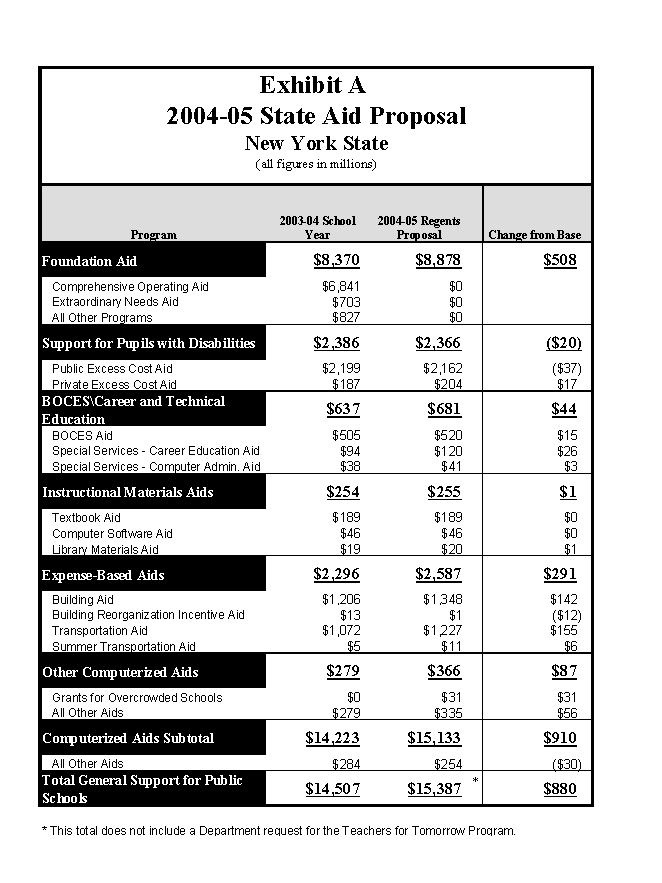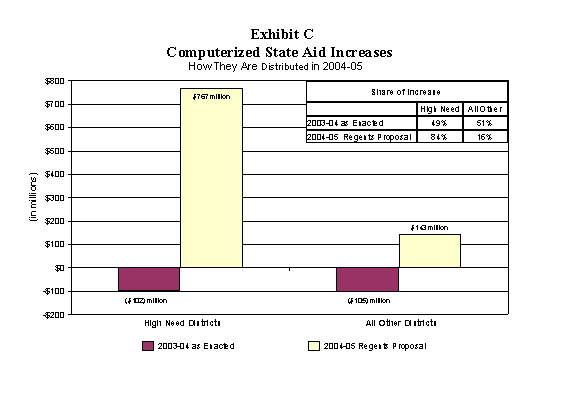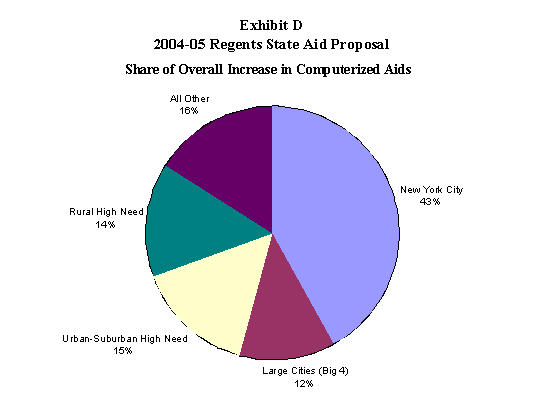Advocacy Plan For Regents 2004-05 State Aid
Proposal
The Regents State Aid proposal for 2004-05
implements a new, multi-year approach to State and local funding of public
schools designed to close the student achievement gap. It proposes a Foundation Formula for the
distribution of State Aid that assists school districts with the costs of
general education instruction, to be phased in over a seven-year period. The goal of the Regents proposal
is:
The State's system of
funding for education should provide adequate resources through a State and
local partnership so that all students have the opportunity to achieve the
State’s learning standards, including resources for extra time and help for
students.
This new approach to State Aid has four basic
components:
District’s State Aid = [Foundation Cost X Pupil Needs Index X Regional Cost
Index] - Expected Local Contribution
§
The Foundation Cost is the cost of providing
general education services in New York schools, measured by determining the
instructional costs of districts that are performing well.
§
The Pupil Needs Index recognizes the added costs of providing extra
time and extra help for students to succeed in school. It is measured by the number of students
eligible for free and reduced-price lunch and students living in geographically
sparse areas of the State.
§
The Regional Cost Index is an adjustment that recognizes regional
variations in purchasing power around the State. It is measured based on wages of
non-school professionals in each region of the State.
§
The Expected Local Contribution is an amount school districts are expected to
spend as their fair share of the total cost of general education. It is measured by multiplying the
district tax base by an expected tax rate adjusted by district income per
child. The Expected Local
Contribution is not a mandated tax rate, but a way of determining a local share
in order to calculate State Aid.
Other aids that are
proposed separately from Foundation Aid include: expense-based aids (Building
and Transportation); aid for pupils with disabilities; Regional Services Aid for
the Big 5 districts; aid for career and technical education; and other
categorical aids (e.g., Universal Pre-K, BOCES Aid, Bilingual Grants/Limited
English Proficient Student Aid, Textbook Aid, Library Materials Aid, and other
programs).
In the first year, Exhibit A shows that an
$880 million increase is proposed, with $508 million of this for Foundation
Aid. Exhibit B shows that when the
proposal is fully implemented, it will provide $14.35 billion in Foundation Aid,
a $5.98 billion increase in Foundation Aid over 2003-04. Over time, this flow of aid to high need
districts will have a significant impact in closing the student achievement
gap.
Exhibit C shows that, in 2004-05, the first
year of the Regents proposal, 84 percent of the increase in school aid would go
to high need school districts to close the achievement gap. Exhibits D and E show the share of
computerized aids for school districts grouped by Need-Resource Capacity
category in the first year of the proposal and with full implementation.

Exhibit B
Regents Foundation Aid Proposal
New York State
(all figures in millions)
| |
Base Year Funding |
Regents Foundation Aid |
Change from Base |
2003-2004 School Year
|
$8,370 |
----- |
----- |
2004-2005 School Year
|
----- |
$8,878 |
$508 |
2010-11 School Year
|
----- |
$14,350 |
$5,980 |


Advocacy
Plan
Goals
·
Long
Term: Passage of the
proposal during the 2004 legislative session.
·
Short
Term: Support for the
proposal from the Governor (Division of the Budget), the leadership of the
Assembly and Senate, and the chairs of the education and financial
committees.
·
Interim
Checks:
-
Inclusion of
concepts in the Executive budget proposal
-
Introduction of
legislation
-
Bill reported
out of Committee and progressing through the legislative
process
-
Letters of
support from educational associations, parents and the business
community
1.
SED
Advocacy
·
Involved
Regents are:
-
State Aid
Advocacy Task Force
-
Subcommittee on
State Aid
-
EMSC-VESID
Committee
-
All
Regents
·
Involved
staff:
-
Commissioner
Mills, Chief Operating Officer, Counsel and Chief of Staff, EMSC Deputy,
Coordinator of School Operations and Management, Director of Education Finance
and State Aid Work Group coordinator. Advice is sought from NYSED’s Director of
Communications and Legislative Coordinator. SED’s State Aid Work Group and the
Legislative Coordinating Team provide periodic advice.
2.
Advocacy
Information
·
Regents
proposal with technical supplement
·
Pamphlet
·
Briefing on
Governor’s budget recommendations
·
Talking
points
·
Frequently
asked questions and suggested answers
·
Articles
(education association journals)
3.
Anticipated
sources of support and how they will be engaged
·
Support
-
School
superintendents, principals and business officials, including the Midstate
School Finance Consortium
-
Presidents of
boards of education
-
Student
advocacy groups such as the Educational Priorities Panel and the Emergency
Coalition for Universal Pre-K
-
Conference of
Large City Boards of Education
-
Parents
interested in extra time and help opportunities for their
children
-
Directors of
special education
·
Engagement
-
Regents
advocacy with local legislators and statewide leaders
-
Public forum
with Regents
-
The State
Education Department’s Educational Finance Advisory Group
-
Widespread use
of a pamphlet and articles with highlights of the proposal
-
Participation
in meetings held by associations and advocacy groups
-
Correspondence
4.
Key
Legislators
1.
Senate
Temporary President and Majority Leader
Minority Leader
Chair, Senate Education Committee, selected
Education Committee members
Ranking Minority Member, Senate Education
Committee
Chair, Senate Finance Committee
Chair of Senate Select Commission on
Disabilities
2.
Assembly
Speaker
Majority Leader
Minority Leader
Chair, Assembly Education Committee, selected
Education Committee members
Ranking Minority Member, Assembly Education
Committee
Chair, Assembly Ways and Means Committee
Chair of the Assembly Task Force on People
with Disabilities
Chair and Co-chair, Black, Puerto Rican and
Hispanic Legislative Caucus
Chair, Puerto Rican/Hispanic Task
Force
5.
Governor's and
Other Executive Offices
6.
Legislative
advocacy throughout the legislative process
Significant events:
§
CFE Study on
the Cost of an Adequate Education (February 28, 2004)
§
Governor’s
Commission on Education Reform (March 1, 2004)
§
Education
Finance Research Consortium Symposium on School Finance (March 4,
2004)
§
State budget
(April 2004)
§
Final date for
State solution (July 30, 2004)
Reach out and participate in statewide
solutions:
§
Sound basic
education task force with educational associations, convened by
CFE
§
School
facilities task force with educational associations, convened by
CFE
§
Accountability
task force with educational associations, convened by CFE
§
Discussions of
similarities and differences of different aid proposals: Regents, Midstate, NYS
Association of School Business Officials, Campaign for Fiscal Equity, Education
Conference Board, Governor’s and legislative budgets



